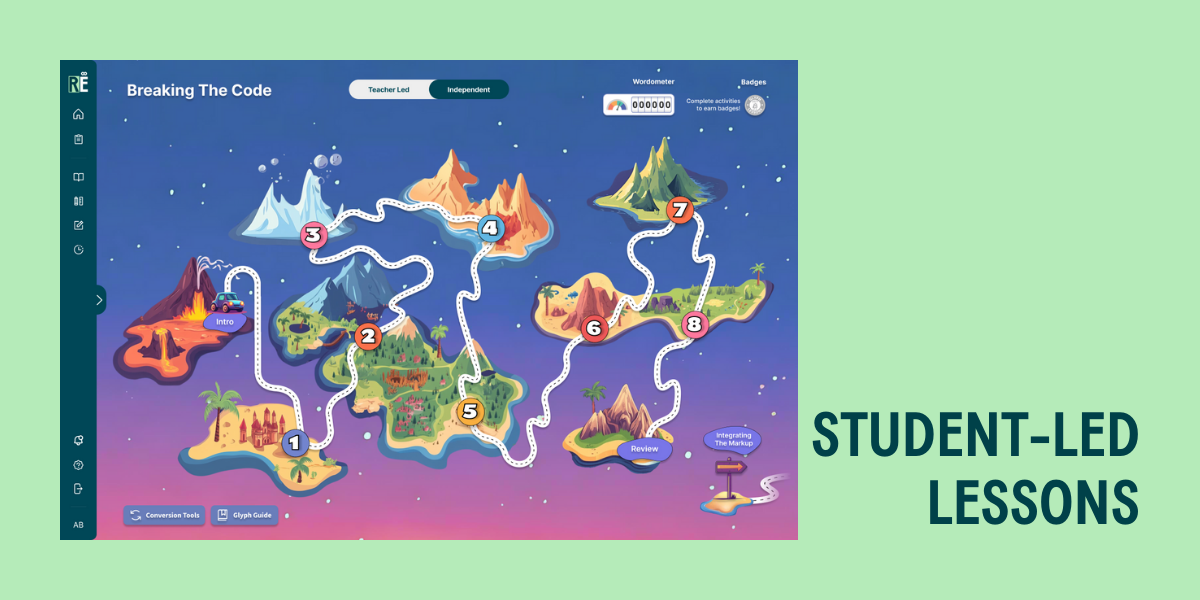Exploring the Student-Led Model of Implementation
Empowering students to take ownership of their learning is one of the most effective ways to foster literacy, confidence, and long-term success. The ...
K-12Discover how Readable English is transforming reading instruction |
PROGRESS MONITORINGEasily assess and monitor growth with data-driven insights and reporting tools |
PROFESSIONAL SERVICESDiscover the services that support your success, from virtual training to expert coaching |
INDIVIDUALSStrengthen your reading skills with an interactive app tailored to your learning needs |
PARENTSEmpower your child's reading journey with an interactive app and expert strategies for home support |
|

|
Rethinking Reading: How One District Transformed Instruction (SmartBrief)Discover how a bold shift in reading instruction helped struggling learners thrive - and the critical role Readable English played in their success.
|
RESEARCH & RESULTSExplore peer-reviewed studies and real-world case studies on Readable English in action |
BLOGExplore articles on feature highlights, research deep-dives, and the latest literacy insights |
EBOOKDownload the ebook Why Learning to Read English is So Hard and how to Make it Easier |
CUSTOMER STORIESDiscover how educators and administrators are transforming literacy with Readable English |
RESOURCE AND PRODUCT ENABLEMENT LIBRARYFind essential educational references and instructional materials to enhance teaching |
FAQSFind essential educational references and instructional materials to enhance teaching |
NEWS & EVENTSStay up to date with media coverage, webinars, and upcoming events featuring Readable English |
|
|
Rethinking Reading: How One District Transformed Instruction (SmartBrief)Discover how a bold shift in reading instruction helped struggling learners thrive - and the critical role Readable English played in their success. |
1 min read
 Anna Boyle
:
Aug 4, 2025
Anna Boyle
:
Aug 4, 2025
If you've ever watched a beginning reader struggle through an unfamiliar word, you've witnessed the importance of decodability firsthand. Decodable words are those a reader can sound out using phonics rules—letter-sound correspondences they’ve already learned. But here’s the problem: only 38% of the 1,000 most common words in English are strictly phonetic. The rest? They either follow complex phonics rules or are exceptions altogether.
At Readable English, we believe every word should be accessible—without compromising vocabulary richness or sentence complexity. That’s why we’ve transformed English into a fully decodable system.
Download the The Power of Decodability Infographic as PDF.

A decodable word is one that a beginning reader can sound out using phonics knowledge. Words like “snap” or “test” follow simple letter-sound rules. Others, like “straight” or “vague,” become decodable as more advanced phonics rules are taught—usually by third grade.
Decodable books contain only the phonics patterns a student has already been taught. These books are crucial in early reading because they:
Build confidence and motivation
Reinforce grapheme–phoneme correspondences
Reduce cognitive load to develop fluency
A breakdown of the 1,000 most common English words reveals:
38% (380 words) are phonetic
35% (350 words) follow one of 45 phonics rules
27% (270 words) are exceptions that must be memorized
This means that without support, nearly two-thirds of common words require advanced phonics instruction or memorization—putting many students at a disadvantage.
What if every word could be decodable—without dumbing down the text?
Readable English makes this possible by adding visual cues:
Grayed-out letters for silent characters
Glyphs that indicate alternate letter sounds
Syllable breaks that aid fluency
Take the word technique: It’s tricky for most young readers. But with Readable English, the phonetic cues make it accessible—right now.
Decodable texts are powerful, but traditionally limited. Students were often confined to basic books using only taught rules. This restricts exposure to rich vocabulary, complex grammar, and diverse sentence structures.
Readable English changes that.
Every word becomes decodable. This means students can engage with authentic, grade-level texts—developing comprehension, vocabulary, syntax, and fluency simultaneously.
Faster decoding
Improved fluency
Reduced cognitive load
Greater equity in literacy outcomes
We’re rethinking what’s possible for reading instruction. With Readable English, every student can access the full power of the English language—phonetically, confidently, independently.
Contact us to schedule a demo today!

Empowering students to take ownership of their learning is one of the most effective ways to foster literacy, confidence, and long-term success. The ...

At first glance, words like five, move, and gone look simple. But for beginning readers, decoding these words can be far from easy. This infographic...

English learners often ask the same question: “Why aren’t words pronounced the way they are spelled?" At Summer Camp Wonder, our seven campers...